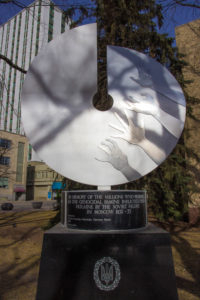Ukrainian Famine of 1933 Memorial, 1983
Location: City Hall, 1 Sir Winston Churchill Square (southwest corner of City Hall grounds)
The first public monument to the Holodomor was erected and dedicated outside City Hall in Edmonton to mark the 50th anniversary of the Soviet-inflicted famine-genocide. The public unveiling in 1983 by then Mayor Laurence Decore boldly proclaimed the existence of the event and spoke of the city’s connection to its Ukrainian community – a large portion of Alberta’s population.
The sculpture of a large broken circle of cold grey metal emblazoned with skeletal hands memorializes the anonymous victims of the Soviet-engineered genocide. The inscription reads: “The twisted and fractured circle represents the life cycle being torn apart by an unnatural force: emaciated hands resist, grasp and then beg for an end to their inhuman condition.”
Ludmilla Temertey’s sculpture symbolizes the scar on humanity left by authoritarian political regimes, and more specifically on the Ukrainian people by Josef Stalin. Commissioned by the Canadian Ukrainian Committee, the monument commemorates the lives lost and acknowledges a little-known and poorly understood event in world history.
The genocidal famine was enacted to punish farmers for resisting the collectivization of agricultural production. The death of the greatest number of civilians during peacetime occurred when food, livestock and seed grain were removed from the country and the borders were sealed. Following the forced famine of millions of people, the Russification of Ukraine saw the extermination of religious, academic, and cultural leaders. Until the fall of the Soviet Union in the 1990s, any record of the genocide was suppressed and those who spoke of it were silenced by the Soviet government.
The sculpture invites examination of the histories constructed by Soviet Russia and allows members of the larger community to show solidarity against injustices committed against humankind. An inscription on the base of the artwork reads: “Let us all stand on guard against tyranny, violence and inhumanity”.
Biography: Ludmilla Temertey is a graphic designer and artist who lives in Montalcino, Italy. She was born “in a haystack” while her family was fleeing from Ukraine in a caravan after losing their land to Stalin’s collective farms. Though her parents spoke little of the horrors they had endured, Temertey later learned that her grandfather was executed after being labeled an agitator for refusing to give up his farm.
Wanting to share her family history, Temertey said, “I understood how much I was defined by my parents’ history, even though I did not live through it. … I wanted to honour those silent victims of this heinous crime against humanity … my family and their indomitable spirit … survivors of the Holodomor.”
Collection: City of Edmonton Public Art Collection
Sources: Edmonton Arts Council, UCC eNewsletter – November 2015, UCRDC interviews Ludmilla Temertey, a child of Holodomor survivors

